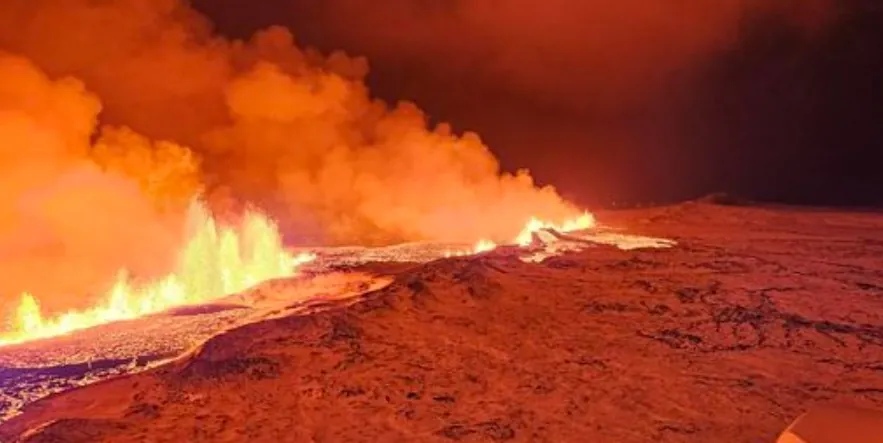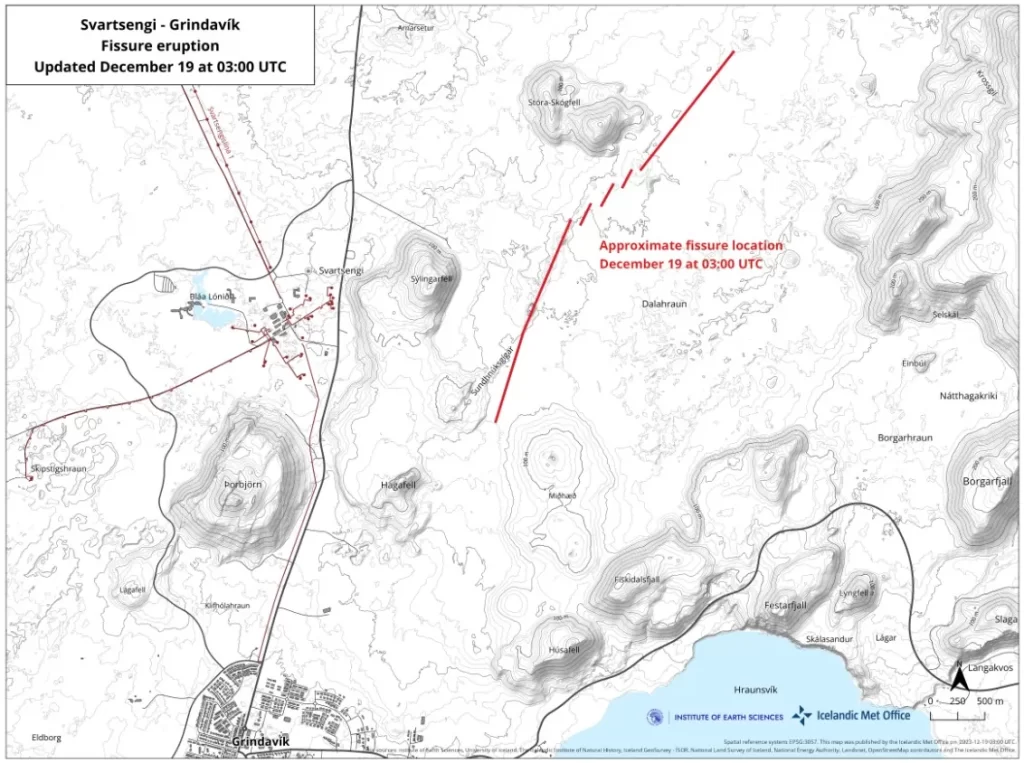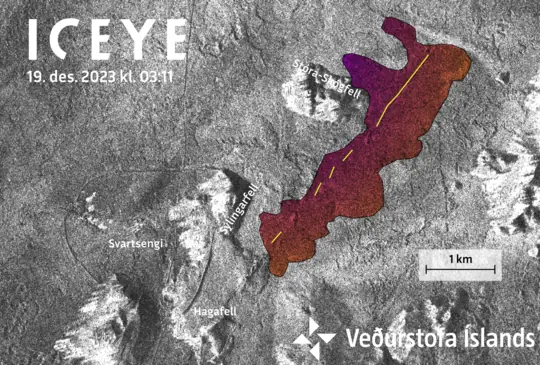Volcanic eruption starts near Grindavik, Reykjanes Peninsula, Iceland

A new volcanic fissure eruption started at 22:17 UTC on December 18, 2023, about 4 km (2.5 miles) NE of the town of Grindavik, Reykjanes, Iceland. The eruptive fissure is about 4 km long, with the northern end just east of Stóra-Skógfell and the southern end just east of Sundhnúk.
The eruption was preceded by an earthquake swarm that started at 21:00 UTC.
According to the aerial observations performed by 02:10 UTC on December 19 as well as seismicity, the eruption fissure is expanding to the south. At the time, the southern end of the fissure was close to Sundhnúkur.
Stunning footage of the Icelandic Coast Guard monitoring and flying over the newly opened volcanic fissure northeast of Grindavík, Iceland 🇮🇸 | 18 December 2023 | #reykjavik #Grindavíkurbær #VolcanicEruption #ReykjanesPeninsula #Iceland#Fagradalsfjall #Grindavík #volcano pic.twitter.com/PilR0rDKsF
— Disaster Tracker (@DisasterTrackHQ) December 19, 2023
The eruption is located on the dyke intrusion that formed in November.
Officials are warning this new eruption is not tourist-friendly and seems to be significantly larger than the Fagradalsfjall in 2021.
The eruptive fissure is currently about 4 km (2.5 miles) long, with the northern end just east of Stóra-Skógfell and the southern end just east of Sundhnúk. The distance from the southern end to the edge of Grindavík is almost 3 km (1.8 miles).

The rate of lava discharge during the first two hours of the eruption was thought to be on a scale of hundreds of cubic meters per second, with the largest lava fountains on the northern end of the fissures.
Lava is spreading laterally from either side of the newly opened fissures. From real-time GPS measurements, significant ground deformation has accompanied the opening of the eruption fissures.
Since midnight UTC on December 19, the level of seismicity at the eruption site has decreased. Additionally, estimates of fissure lengthening suggest that the eruption has decreased in intensity since its onset. “The decrease in intensity is evident from seismic and GPS measurements,” the Icelandic Met Office said.
However, the fact that the activity is decreasing already is not an indication of how long the eruption will last, but rather that the eruption is reaching a state of equilibrium. This development has been observed at the beginning of all eruptions on the Reykjanes Peninsula in recent years.
A meeting of scientists will be held on the morning of December 19 (LT) to evaluate the overnight development of the eruption.

Updates
12:55 UTC, December 20
Large lava fountains were observed at the beginning of the eruption and intense seismicity over the dike.
The power of the eruption has decreased with time as well as the seismicity and deformation, IMO reported at 10:53 UTC today.
On the latest surveillance photos, the activity is now constrained to 2 craters, but was earlier three, SE of Stóra-Skógafell.
According to IMO, the fact that the activity is decreasing already is not an indication of how long the eruption will last, but rather that the eruption is reaching a state of equilibrium. “This development has been observed at the beginning of all eruptions on the Reykjanes Peninsula in recent years.”
14:20 UTC, December 21
The Icelandic Meteorological Office (IMO) reported at 12:55 UTC on December 21, 2023, that there is no visible eruptive activity at the Sundhnúksgígar site in Reykjanes, Iceland. Scientists flying over the eruption site confirmed that lava flow from the craters seems to have ceased, with glowing still visible in the lava field, likely within closed channels.
The activity appears to have diminished late last night or very early this morning. However, it is still possible that lava is flowing in closed channels, so it is premature to declare the eruption over.
Featured image credit: IMO

All hotspot volcanoes will erupt in 2024. Hotspot volcanoes are volcanoes that form from plumes of molten rock that rise from a deep source in Earth’s mantle. The reason has to do with the shifting of earth’s magnetic field, which depends on the energy level at the Earth’s interior.
Hi Jamal, nice to see you commenting on here sharing your knowledge, which is brilliant to say the least.